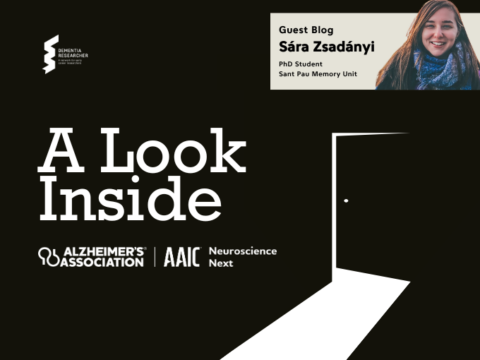As a scientist working in a specific area, using specific techniques to conduct your research, imagine being shown how a new method could generate data faster and at a higher quality, without compromising the science. What would it take for you to change your approach? In this blog, I will discuss some of the barriers to innovation, how they can impede scientific progress in fields like dementia research, and why scientists should be more open to accepting change.
I first started thinking about this topic seven years ago. As a regional programme manager for the NC3Rs (the National Centre for the Replacement, Refinement, and Reduction of Animals in Research), a UK-based scientific organisation and research funder, one of my responsibilities was to promote the uptake of new research methods and technologies where there was evidence showing a significant benefit to animal welfare. This could be through Replacement, which is no longer using animals in studies where they would have previously been used, such as using human tissue or cells, or mathematical modelling; through Refinement, which is using methods that improve animal welfare and minimise any potential suffering, such as through using certain handling techniques which reduce stress; or through Reduction, which involves minimising the number of animals used to obtain statistically meaningful results, such as through using longitudinal imaging technologies to avoid needing multiple animal cohorts.
Typically, the new research methods and technologies I was promoting would have published data to support how that innovation had a 3Rs benefit, either without compromising the quality or quantity of experimental data or improving on it. So surely it must have been very easy for me to convince scientists to adopt these new methods and technologies in their own research, right? Well actually it turned out to be one of the most challenging aspects of my job. Surprisingly, scientists can be reluctant to take up new approaches which could not only potentially improve the quality, quantity, and/or reliability of their data, but also have an animal welfare benefit. It is therefore important to understand why such barriers exist in order to develop strategies to tackle them.

NC3Rs leads the discovery and application of new technologies and approaches to replace, reduce and refine the use of animals for scientific purposes.
The gap between the development of new methods and technologies and their subsequent implementation has been described as the “Valley of Death”, and is applicable to any innovation in the biosciences, not just those relating to the 3Rs. The Valley of Death represents the reluctance of scientists in adopting these new approaches and so off to the Valley these technologies go to die, never to emerge again. The barriers for adoption can be complex, with one reason being the resource investment required to change current approaches. New equipment may be required along with the necessary training, all of which comes at both a time and financial cost. These concerns are legitimate, and researchers do care about whether any alternatives can be more efficient, cheaper, and/or shown to improve welfare in animal-based studies, however, I found that it was not their primary concern because if an issue could be addressed, up popped another one. The greatest barrier seemed to be a general reluctance to change, leaving us with no obvious solution to address it.
So where might this general reluctance to change come from? Learning about good research practice is part of our scientific training. Typically, this will include learning to control for extraneous variables which can impact on the outcome of studies and may involve a lot of time perfecting a method to achieve this. This generates confidence in the method, and data to use as a direct comparison in future studies. It is therefore going to be challenging to expect researchers to take what might feel like a leap of faith and overcome sceptical promises of scientific or welfare benefit. Unlike resource issues, it isn’t immediately clear what can be done to address a general reluctance to change, as the barrier is a cultural one requiring real behaviour change. Publishing a growing evidence base in support of a new approach is necessary, but not sufficient, to convince researchers. So, as with many problems in academia, we can start by looking at how research is funded.
Decisions around research funding in the UK are made for scientists, by scientists. The scientists reviewing grant applications and sitting on review boards making decisions on who to allocate funding to, and which projects to fund, are the same people using established methods and may be more focused on maintaining these approaches in order to not supplant their own research. As a consequence of this highly selective process, everyone has at least one story about how a grant application of theirs was unfairly reviewed or scored, questioning if it was even read never mind understood. The process is inherently biased, one which we know disproportionately affects women and those in minority groups. Added to this, research funders are risk averse, meaning it is a much safer bet to allocate funding to the well-known PI who uses well-establishing methods. We all know this happens, so researchers are not rewarded, or even motivated, to disrupt the status quo by adopting new approaches. Through this system of research funding, innovation is implicitly discouraged. Some funding schemes do exist, but they are often highly complicated and lack support for researchers unfamiliar with a different funding structure, so we need greater support and dedicated initiatives focussed on widespread uptake of new methods to motivate researchers to explore alternatives.
So what does all this mean for dementia research? Progress is being made in the development of treatments targeting β-amyloid for Alzheimer’s disease, the most common brain disease which leads to dementia, with recent trial success. However, effects remain small and because post-mortem studies have shown that the brains of people with dementia often have multiple pathologies, it is likely that targeting various disease mechanisms is going to be required to truly improve outcomes. Arguably, innovation is needed in dementia research now more than in any other area of biomedical science.
In addition to building an evidence base, and more direct funding initiatives for innovation and widespread uptake, scientists need to be more open to adopting change. Afterall, they are the end users and can help to develop strategies to address resource issues associated with changing approaches.
We need scientific progress in dementia research now more than ever, so we need to ensure this is not impeded by any barriers to innovation which could be overcome.

Dr Kamar Ameen-Ali
Author
Dr Kamar Ameen-Ali is a Lecturer in Biomedical Science at Teesside University & Affiliate Researcher at Glasgow University. In addition to teaching, Kamar is exploring how neuroinflammation following traumatic brain injury contributes to the progression of neurodegenerative diseases that lead to dementia. Having first pursued a career as an NHS Psychologist, Kamar went back to University in Durham to look at rodent behavioural tasks to completed her PhD, and then worked as a regional Programme Manager for NC3Rs.

 Print This Post
Print This Post




